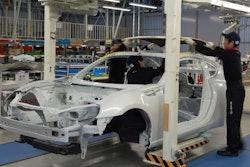One of the main purposes of technology innovation is to make tasks cheaper and more efficient. That is particularly the case in the logistics arena, where technology can help make employees more effective and end customers more satisfied.
There have already been huge advances made in logistics in recent years, and it will only improve as innovation continues to evolve. Here is a quick look at five trends in technology, the roles they play in logistics and how they may shape the future.
1. 3D Printing
The term "3D printing" has been a buzz phrase for some time, and it's now poised to play a huge role in the world of logistics and supply chain management.
In the industry, 3D printing is called additive manufacturing, and it's already big business that continues to skyrocket. In 2016, the 3D printing market reached $5.17 billion, up 26 percent from the previous year.
Since 3D printing allows companies to produce items on the spot, it can help the logistics industry in a couple of different ways. First, it can reduce the amount of storage space needed for replacement parts. If you can produce parts on demand, there’s no need to waste space to store them.
Also, 3D printing can help make shipping more efficient. It allows the production of many different types of items on the fly, meaning less need to ship certain items long distances.
2. Internet of Things
The Internet of Things (IoT) is another buzz-worthy phrase, but most everyday consumers think of it as a way to connect household items such as your thermostat or refrigerator.
In logistics and other industries, the IoT is all about connecting machines and systems so they can communicate and learn from each other over time.
With everything connected, it makes efficiency a much more attainable prospect. For example, in factory or plant situations, IoT technology allows managers to quickly check on things such as energy consumption, the production levels of specific machines or sectors, the overall flow of product and the status of key inventory.
All this makes potential problems quickly identifiable, reducing waste and potentially bigger problems down the line.
Also, because IoT systems learn over time, they're able to predict potential problems before they even happen. In the end, it will save companies both time and money.
3. Mobile Robots
Forklifts have been a key component to warehouses for decades, and we're now seeing a shift toward automating this portion of the supply chain.
Again, the primary goal here is improved efficiency. Amazon is a prime example in this space thanks to its acquisition of Kiva Systems, now known as Amazon Robotics. As it and other companies have shown, bringing robotics and autonomous machinery into the fold can reduce delivery times to just a 24- to 48-hour period.
In the old days, ordering products by mail could take four to six weeks for delivery, if not more. The likes of Amazon have since obliterated that model, feeding into consumers' desire to get what they want, when they want it.
Autonomous forklifts and robots can pick products much faster than human counterparts, and it means companies don't have to pay human forklift operators. This combination of lower costs and more rapid production is what business owners dream about.
4. Drones
Ten years ago, drones were mainly known for their military acumen and ability to spy on or even attack enemies without putting humans in the line of fire. These days, drones are seemingly everywhere, whether it's taking cool wedding photos or videos, filming large crowds at concerts or racing through abandoned warehouses on ESPN2.
The next logical step for drones is logistics. Amazon famously floated the idea of delivering some of its products using drones, and while it seemed far-fetched at the time, that reality now seems inevitable.
In the future, drones could be used for several key tasks. They could help with product picking in warehouse facilities. They could make rural deliveries to help save gas and manpower. They could even help with security and surveillance to keep businesses and employees safe.
5. Trucking and Brokerage
Freight brokerage is a huge arm of the logistics world, and it too may soon see the impacts of technological innovation.
As it stands, one of the main ideas invading freight brokerage is the potential of an Uber-like system in which a mobile app could help match shippers and drivers. The idea is to cut out the middleman, which at the end of the day could help save money on shipping.
Looking ahead, freight brokerage could jump on the autonomous vehicle trend, which would make shipping items across the country safer and more efficient. Of course, we're still a long way from autonomous vehicles taking over the mainstream, but there is a great chance it happens in our lifetimes.
The logistics industry is not immune to the advances in technology over recent years. As tech continues to progress, it only stands to make logistics faster, more efficient — and, perhaps most importantly, more profitable.
Kayla Matthews is an independent technology writer at Productivity Bytes.






















